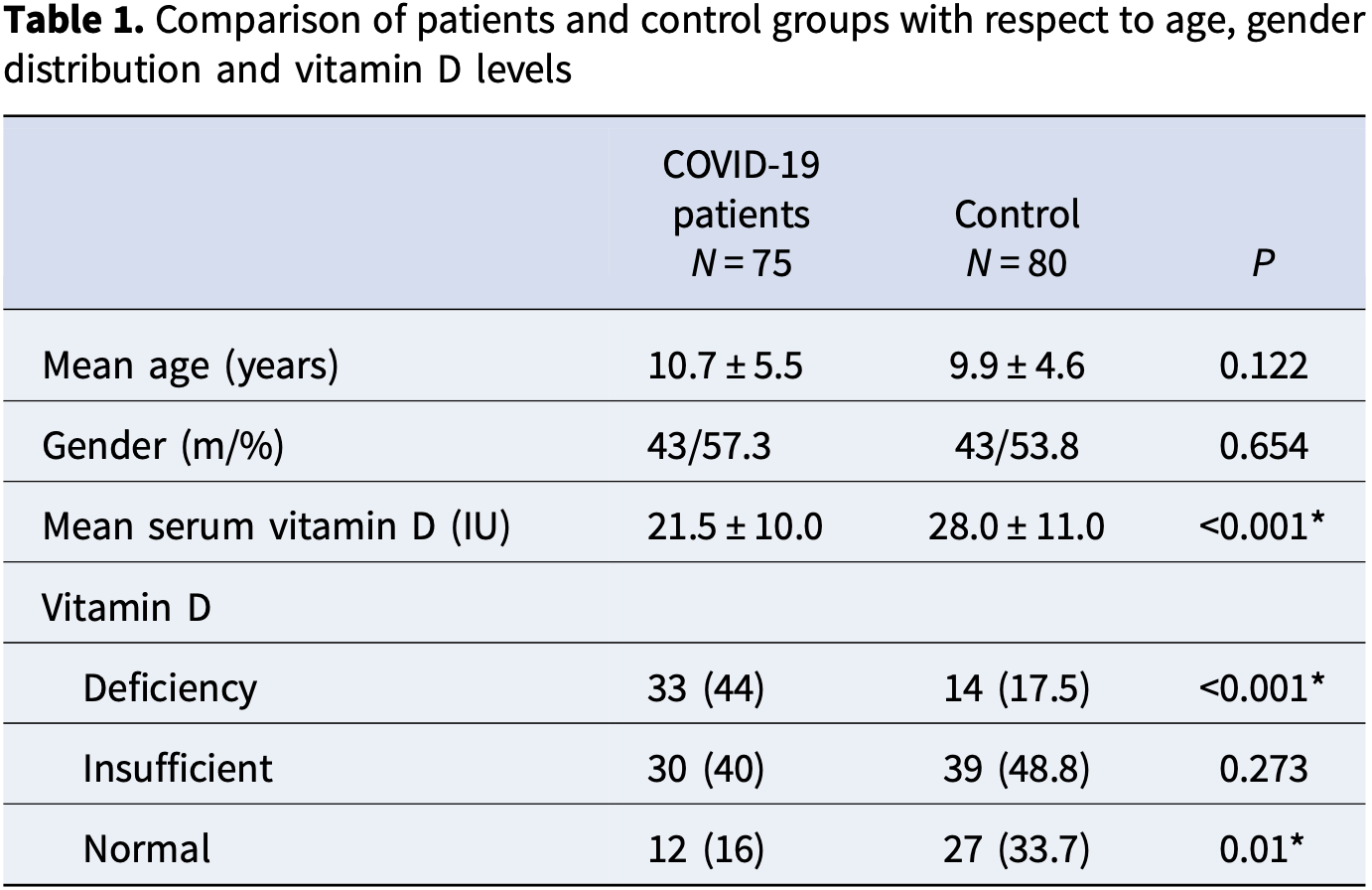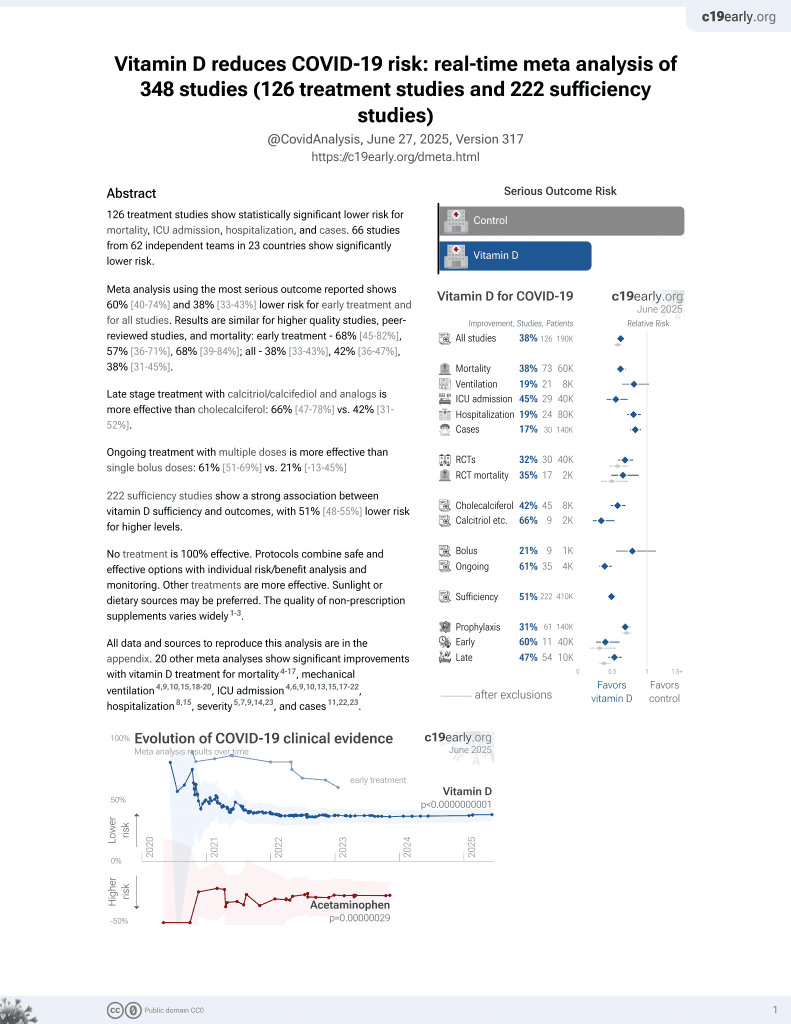
Vitamin D levels in children with COVID-19: a report from Turkey
et al., Epidemiology & Infection, doi:10.1017/S0950268821001825, Aug 2021
Vitamin D for COVID-19
8th treatment shown to reduce risk in
October 2020, now with p < 0.00000000001 from 136 studies, recognized in 18 countries.
No treatment is 100% effective. Protocols
combine treatments.
6,300+ studies for
210+ treatments. c19early.org
|
Retrospective 75 COVID-19 hospitalized pediatric patients in Turkey and 80 healthy controls, showing significantly lower vitamin D levels in COVID-19 patients.
This is the 86th of 226 COVID-19 sufficiency studies for vitamin D, which collectively show higher levels reduce risk with p<0.0000000001 (1 in 115,066,047,903,039,356,928 vigintillion).
|
risk of case, 73.0% lower, OR 0.27, p < 0.001, high D levels 42 of 75 (56.0%) cases,
66 of 80 (82.5%) controls, NNT 3.2, case control OR, >20ng/mL.
|
| Effect extraction follows pre-specified rules prioritizing more serious outcomes. Submit updates |
Alpcan et al., 10 Aug 2021, retrospective, Turkey, peer-reviewed, 3 authors.
Vitamin D levels in children with COVID-19: a report from Turkey
Epidemiology and Infection, doi:10.1017/s0950268821001825
Several studies have demonstrated that higher levels of vitamin D are associated with better prognosis and outcomes in infectious diseases. We aimed to compare the vitamin D levels of paediatric patients with mild/moderate coronavirus disease 2019 (COVID-19) disease and a healthy control group. We retrospectively reviewed the medical records of patients who were hospitalised at our university hospital with the diagnosis of COVID-19 during the period between 25 May 2020 and 24 December 2020. The mean age of the COVID-19 patients was 10.7 ± 5.5 years (range 1-18 years); 43 (57.3%) COVID-19 patients were male. The mean serum vitamin D level was significantly lower in the COVID-19 group than the control group (21.5 ± 10.0 vs. 28.0 ± 11.0 IU, P < 0.001). The proportion of patients with vitamin D deficiency was significantly higher in the COVID-19 group than the control group (44% vs. 17.5%, P < 0.001). Patients with low vitamin D levels were older than the patients with normal vitamin D levels (11.6 ± 4.9 vs. 6.2 ± 1.8 years, P = 0.016). There was a significant male preponderance in the normal vitamin D group compared with the low vitamin D group (91.7% vs. 50.8%, P = 0.03). C-reactive protein level was higher in the low vitamin D group, although the difference did not reach statistical significance (9.6 ± 2.2 vs. 4.5 ± 1.6 mg/l, P = 0.074). Our study provides an insight into the relationship between vitamin D deficiency and COVID-19 for future studies. Empiric intervention with vitamin D can be justified by low serum vitamin D levels.
Author contributions. AA and YK contributed to the analysis and drafted the manuscript. ST helped to evaluate the subjects. YK designed and critically revised the manuscript. All authors have read and approved the final form of the manuscript. Financial support. None.
Conflict of interest. None. Ethical standards. The ethics committee approval of the study was obtained from the Kirikkale University Clinical Research Ethics Committee (Date: 25.02.2021/Decision no:2021.02.03). Written informed consent was not obtained from the legal guardians of the patients in this study because this is a retrospective study and the patients had been discharged when the study was carried out. All methods were carried out in accordance with relevant guidelines and regulations. Consent for publication. Not applicable.
References
Akoğlu, Evaluation of childhood COVID-19 cases: a retrospective analysis, Journal of Pediatric Infectious Diseases
Ali, Role of vitamin D in preventing of COVID-19 infection, progression and severity, Journal of Infection and Public Health
Amaya-Mejia, Vitamin D deficiency in patients with common variable immunodeficiency, with autoimmune diseases and bronchiectasis, Revista Alergia México
Aranow, Vitamin D and the immune system, Journal of Investigative Medicine
Cantorna, Vitamin D and 1,25(OH)2D regulation of T cells, Nutrients
Chen, First case of severe childhood novel coronavirus pneumonia in China. Zhonghua er ke za zhi, Chinese Journal of Pediatrics
Daneshkhah, The role of vitamin D in suppressing cytokine storm in COVID-19 patients and associated mortality, doi:10.1101/2020.04.08.20058578v1.full.pdf
Dong, Epidemiological characteristics of 2143 pediatric patients with 2019 coronavirus disease in China, Pediatrics
Henry, Lippi, Plebani, Laboratory abnormalities in children with novel coronavirus disease 2019, Clinical Chemistry and Laboratory Medicine
Hollis, Wagner, Normal serum vitamin D levels, New England Journal of Medicine
Ishiura, Prostaglandin I2 enhances cough reflex sensitivity to capsaicin in the asthmatic airway, Cough
Laaksi, Vitamin D supplementation for the prevention of acute respiratory tract infection: a randomized, double-blinded trial among young Finnish men, The Journal of Infectious Diseases
Lai, Severe acute respiratory syndrome coronavirus 2 (SARS-CoV-2) and corona virus disease-2019 (COVID-19): the epidemic and the challenges, International Journal of Antimicrobial Agents
Lemire, Immunomodulatory role of 1,25-dihydroxyvitamin D3, Journal of Cellular Biochemistry
Liu, Toll-like receptor triggering of a vitamin D-mediated human antimicrobial response, Science
Liu, Vitamin D modulates prostaglandin E2 synthesis and degradation in human lung fibroblasts, American Journal of Respiratory Cell and Molecular Biology
Lynch, Magnitude and kinetics of anti-SARS-CoV-2 antibody responses and their relationship to disease severity, Clinical Infectious Diseases
Manion, Vitamin D deficiency is associated with IL-6 levels and monocyte activation in HIV-infected persons, PLoS ONE
Martens, Vitamin D's effect on immune function, Nutrients
Nayan, The clinical respiratory score predicts paediatric critical care disposition in children with respiratory distress presenting to the emergency department, BMC Pediatrics
Panfili, Possible role of vitamin D in Covid-19 infection in pediatric population, Journal of Endocrinological investigation
Tezer, Demirdağ, Novel coronavirus disease (COVID-19) in children, Turkish Journal of Medical Sciences
Williams, Chambers, The mercurial nature of neutrophils: still an enigma in ARDS?, American Journal of Physiology -Lung Cellular and Molecular Physiology
Yılmaz, Şen, Is vitamin D deficiency a risk factor for COVID-19 in children?, Pediatr Pulmonology
Zhou, Pathogenic T cells and inflammatory monocytes incite inflammatory storm in severe COVID-19 patients, National Science Review
Zhou, The association between vitamin D deficiency and community-acquired pneumonia: a meta-analysis of observational studies, Medicine
DOI record:
{
"DOI": "10.1017/s0950268821001825",
"ISSN": [
"0950-2688",
"1469-4409"
],
"URL": "http://dx.doi.org/10.1017/S0950268821001825",
"abstract": "<jats:title>Abstract</jats:title><jats:p>Several studies have demonstrated that higher levels of vitamin D are associated with better prognosis and outcomes in infectious diseases. We aimed to compare the vitamin D levels of paediatric patients with mild/moderate coronavirus disease 2019 (COVID-19) disease and a healthy control group. We retrospectively reviewed the medical records of patients who were hospitalised at our university hospital with the diagnosis of COVID-19 during the period between 25 May 2020 and 24 December 2020. The mean age of the COVID-19 patients was 10.7 ± 5.5 years (range 1–18 years); 43 (57.3%) COVID-19 patients were male. The mean serum vitamin D level was significantly lower in the COVID-19 group than the control group (21.5 ± 10.0<jats:italic>vs</jats:italic>. 28.0 ± 11.0 IU,<jats:italic>P</jats:italic>< 0.001). The proportion of patients with vitamin D deficiency was significantly higher in the COVID-19 group than the control group (44%<jats:italic>vs.</jats:italic>17.5%,<jats:italic>P</jats:italic>< 0.001). Patients with low vitamin D levels were older than the patients with normal vitamin D levels (11.6 ± 4.9<jats:italic>vs.</jats:italic>6.2 ± 1.8 years,<jats:italic>P</jats:italic>= 0.016). There was a significant male preponderance in the normal vitamin D group compared with the low vitamin D group (91.7%<jats:italic>vs.</jats:italic>50.8%,<jats:italic>P</jats:italic>= 0.03). C-reactive protein level was higher in the low vitamin D group, although the difference did not reach statistical significance (9.6 ± 2.2<jats:italic>vs.</jats:italic>4.5 ± 1.6 mg/l,<jats:italic>P</jats:italic>= 0.074). Our study provides an insight into the relationship between vitamin D deficiency and COVID-19 for future studies. Empiric intervention with vitamin D can be justified by low serum vitamin D levels.</jats:p>",
"alternative-id": [
"S0950268821001825"
],
"article-number": "e180",
"assertion": [
{
"group": {
"label": "Copyright and Licensing",
"name": "copyright_and_licensing"
},
"label": "Copyright",
"name": "copyright",
"value": "Copyright © The Author(s), 2021. Published by Cambridge University Press"
},
{
"group": {
"label": "Copyright and Licensing",
"name": "copyright_and_licensing"
},
"label": "License",
"name": "license",
"value": "This is an Open Access article, distributed under the terms of the Creative Commons Attribution licence (http://creativecommons.org/licenses/by/4.0/), which permits unrestricted re-use, distribution and reproduction, provided the original article is properly cited."
},
{
"label": "Free to read",
"name": "free",
"value": "This content has been made available to all."
}
],
"author": [
{
"affiliation": [],
"family": "Alpcan",
"given": "Aysegul",
"sequence": "first"
},
{
"affiliation": [],
"family": "Tursun",
"given": "Serkan",
"sequence": "additional"
},
{
"ORCID": "http://orcid.org/0000-0002-8361-5558",
"affiliation": [],
"authenticated-orcid": false,
"family": "Kandur",
"given": "Yaşar",
"sequence": "additional"
}
],
"container-title": "Epidemiology and Infection",
"container-title-short": "Epidemiol. Infect.",
"content-domain": {
"crossmark-restriction": true,
"domain": [
"cambridge.org"
]
},
"created": {
"date-parts": [
[
2021,
8,
10
]
],
"date-time": "2021-08-10T23:24:39Z",
"timestamp": 1628637879000
},
"deposited": {
"date-parts": [
[
2023,
1,
7
]
],
"date-time": "2023-01-07T02:36:40Z",
"timestamp": 1673059000000
},
"indexed": {
"date-parts": [
[
2024,
3,
27
]
],
"date-time": "2024-03-27T18:37:06Z",
"timestamp": 1711564626144
},
"is-referenced-by-count": 27,
"issued": {
"date-parts": [
[
2021
]
]
},
"language": "en",
"license": [
{
"URL": "http://creativecommons.org/licenses/by/4.0/",
"content-version": "unspecified",
"delay-in-days": 221,
"start": {
"date-parts": [
[
2021,
8,
10
]
],
"date-time": "2021-08-10T00:00:00Z",
"timestamp": 1628553600000
}
}
],
"link": [
{
"URL": "https://www.cambridge.org/core/services/aop-cambridge-core/content/view/S0950268821001825",
"content-type": "unspecified",
"content-version": "vor",
"intended-application": "similarity-checking"
}
],
"member": "56",
"original-title": [],
"prefix": "10.1017",
"published": {
"date-parts": [
[
2021
]
]
},
"published-online": {
"date-parts": [
[
2021,
8,
10
]
]
},
"published-print": {
"date-parts": [
[
2021
]
]
},
"publisher": "Cambridge University Press (CUP)",
"reference": [
{
"DOI": "10.1152/ajplung.00311.2013",
"doi-asserted-by": "publisher",
"key": "S0950268821001825_ref3"
},
{
"article-title": "Vitamin D deficiency in patients with common variable immunodeficiency, with autoimmune diseases and bronchiectasis",
"author": "Amaya-Mejia",
"first-page": "110",
"journal-title": "Revista Alergia México",
"key": "S0950268821001825_ref10",
"volume": "60",
"year": "2013"
},
{
"DOI": "10.1086/654881",
"doi-asserted-by": "publisher",
"key": "S0950268821001825_ref12"
},
{
"article-title": "Epidemiological characteristics of 2143 pediatric patients with 2019 coronavirus disease in China",
"author": "Dong",
"first-page": "712",
"journal-title": "Pediatrics",
"key": "S0950268821001825_ref16",
"volume": "58",
"year": "2020"
},
{
"DOI": "10.1165/rcmb.2013-0211OC",
"article-title": "Vitamin D modulates prostaglandin E2 synthesis and degradation in human lung fibroblasts",
"author": "Liu",
"doi-asserted-by": "crossref",
"first-page": "40",
"journal-title": "American Journal of Respiratory Cell and Molecular Biology",
"key": "S0950268821001825_ref19",
"volume": "50",
"year": "2014"
},
{
"article-title": "The role of vitamin D in suppressing cytokine storm in COVID-19 patients and associated mortality",
"author": "Daneshkhah",
"journal-title": "medRxiv",
"key": "S0950268821001825_ref21",
"year": "2020"
},
{
"DOI": "10.1093/nsr/nwaa041",
"doi-asserted-by": "publisher",
"key": "S0950268821001825_ref22"
},
{
"DOI": "10.1093/cid/ciaa979",
"doi-asserted-by": "publisher",
"key": "S0950268821001825_ref25"
},
{
"DOI": "10.1007/s40618-020-01327-0",
"doi-asserted-by": "publisher",
"key": "S0950268821001825_ref26"
},
{
"DOI": "10.1097/MD.0000000000017252",
"doi-asserted-by": "publisher",
"key": "S0950268821001825_ref23"
},
{
"DOI": "10.1126/science.1123933",
"doi-asserted-by": "publisher",
"key": "S0950268821001825_ref6"
},
{
"DOI": "10.1016/j.jiph.2020.06.021",
"doi-asserted-by": "publisher",
"key": "S0950268821001825_ref27"
},
{
"DOI": "10.3390/nu12051248",
"doi-asserted-by": "publisher",
"key": "S0950268821001825_ref9"
},
{
"DOI": "10.1055/s-0041-1723957",
"article-title": "Evaluation of childhood COVID-19 cases: a retrospective analysis",
"author": "Akoğlu",
"doi-asserted-by": "crossref",
"first-page": "091",
"journal-title": "Journal of Pediatric Infectious Diseases",
"key": "S0950268821001825_ref18",
"volume": "16",
"year": "2021"
},
{
"article-title": "Prostaglandin I2 enhances cough reflex sensitivity to capsaicin in the asthmatic airway",
"author": "Ishiura",
"first-page": "2",
"journal-title": "Cough (London, England)",
"key": "S0950268821001825_ref20",
"volume": "3",
"year": "2007"
},
{
"DOI": "10.1017/S0007114521001562",
"doi-asserted-by": "publisher",
"key": "S0950268821001825_ref11"
},
{
"DOI": "10.2310/JIM.0b013e31821b8755",
"doi-asserted-by": "publisher",
"key": "S0950268821001825_ref7"
},
{
"DOI": "10.3390/nu7043011",
"doi-asserted-by": "publisher",
"key": "S0950268821001825_ref8"
},
{
"DOI": "10.1515/cclm-2020-0272",
"doi-asserted-by": "publisher",
"key": "S0950268821001825_ref15"
},
{
"DOI": "10.1186/s12887-018-1317-2",
"doi-asserted-by": "publisher",
"key": "S0950268821001825_ref14"
},
{
"DOI": "10.1371/journal.pone.0175517",
"doi-asserted-by": "publisher",
"key": "S0950268821001825_ref24"
},
{
"DOI": "10.1002/jcb.240490106",
"doi-asserted-by": "publisher",
"key": "S0950268821001825_ref5"
},
{
"DOI": "10.1016/j.ijantimicag.2020.105924",
"doi-asserted-by": "publisher",
"key": "S0950268821001825_ref1"
},
{
"DOI": "10.1056/NEJM200502033520521",
"article-title": "Normal serum vitamin D levels",
"author": "Hollis",
"doi-asserted-by": "crossref",
"first-page": "515",
"journal-title": "New England Journal of Medicine",
"key": "S0950268821001825_ref13",
"volume": "352",
"year": "2005"
},
{
"DOI": "10.3906/sag-2004-174",
"doi-asserted-by": "publisher",
"key": "S0950268821001825_ref4"
},
{
"article-title": "First case of severe childhood novel coronavirus pneumonia in China",
"author": "Chen",
"first-page": "179",
"journal-title": "Zhonghua er ke za zhi. Chinese Journal of Pediatrics",
"key": "S0950268821001825_ref2",
"volume": "58",
"year": "2020"
},
{
"DOI": "10.1002/ppul.25106",
"doi-asserted-by": "publisher",
"key": "S0950268821001825_ref17"
}
],
"reference-count": 27,
"references-count": 27,
"relation": {},
"resource": {
"primary": {
"URL": "https://www.cambridge.org/core/product/identifier/S0950268821001825/type/journal_article"
}
},
"score": 1,
"short-title": [],
"source": "Crossref",
"subject": [
"Infectious Diseases",
"Epidemiology"
],
"subtitle": [],
"title": "Vitamin D levels in children with COVID-19: a report from Turkey",
"type": "journal-article",
"update-policy": "http://dx.doi.org/10.1017/policypage",
"volume": "149"
}
